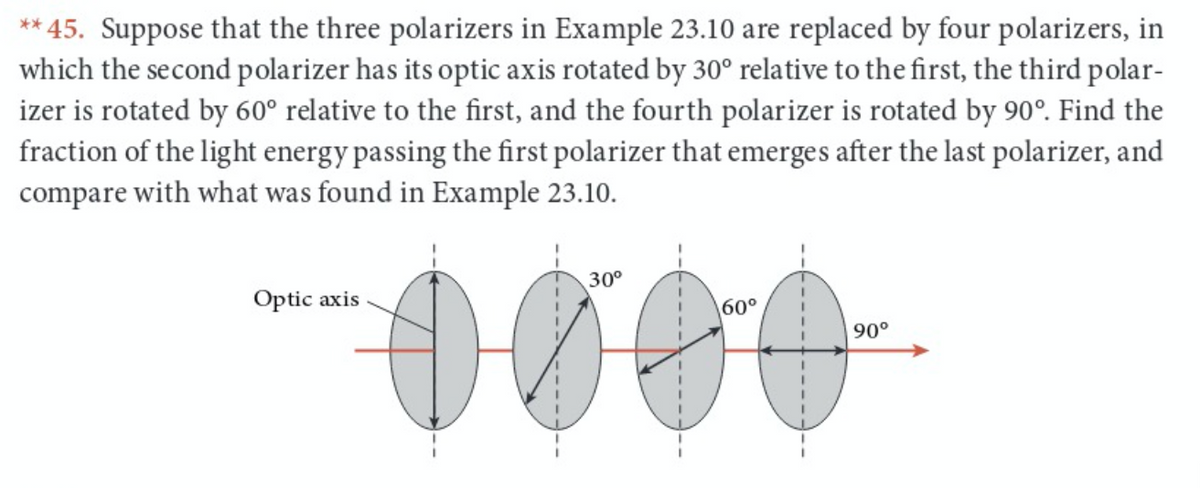** 45. Suppose that the three polarizers in Example 23.10 are replaced by four polarizers, in which the second polarizer has its optic axis rotated by 30° relative to the first, the third polar- izer is rotated by 60° relative to the first, and the fourth polarizer is rotated by 90°. Find the fraction of the light energy passing the first polarizer that emerges after the last polarizer, and compare with what was found in Example 23.10. 30° Optic axis 60° 90°
** 45. Suppose that the three polarizers in Example 23.10 are replaced by four polarizers, in which the second polarizer has its optic axis rotated by 30° relative to the first, the third polar- izer is rotated by 60° relative to the first, and the fourth polarizer is rotated by 90°. Find the fraction of the light energy passing the first polarizer that emerges after the last polarizer, and compare with what was found in Example 23.10. 30° Optic axis 60° 90°
Physics for Scientists and Engineers, Technology Update (No access codes included)
9th Edition
ISBN:9781305116399
Author:Raymond A. Serway, John W. Jewett
Publisher:Raymond A. Serway, John W. Jewett
Chapter38: Diffraction Patterns And Polarization
Section: Chapter Questions
Problem 38.51P: Three polarizing plates whose planes are parallel are centered on a common axis. The directions of...
Related questions
Question

Transcribed Image Text:** 45. Suppose that the three polarizers in Example 23.10 are replaced by four polarizers, in
which the second polarizer has its optic axis rotated by 30° relative to the first, the third polar-
izer is rotated by 60° relative to the first, and the fourth polarizer is rotated by 90°. Find the
fraction of the light energy passing the first polarizer that emerges after the last polarizer, and
compare with what was found in Example 23.10.
000
30°
Optic axis
60°
90°
Expert Solution
This question has been solved!
Explore an expertly crafted, step-by-step solution for a thorough understanding of key concepts.
Step by step
Solved in 2 steps with 2 images

Knowledge Booster
Learn more about
Need a deep-dive on the concept behind this application? Look no further. Learn more about this topic, physics and related others by exploring similar questions and additional content below.Recommended textbooks for you

Physics for Scientists and Engineers, Technology …
Physics
ISBN:
9781305116399
Author:
Raymond A. Serway, John W. Jewett
Publisher:
Cengage Learning

Physics for Scientists and Engineers: Foundations…
Physics
ISBN:
9781133939146
Author:
Katz, Debora M.
Publisher:
Cengage Learning

College Physics
Physics
ISBN:
9781305952300
Author:
Raymond A. Serway, Chris Vuille
Publisher:
Cengage Learning

Physics for Scientists and Engineers, Technology …
Physics
ISBN:
9781305116399
Author:
Raymond A. Serway, John W. Jewett
Publisher:
Cengage Learning

Physics for Scientists and Engineers: Foundations…
Physics
ISBN:
9781133939146
Author:
Katz, Debora M.
Publisher:
Cengage Learning

College Physics
Physics
ISBN:
9781305952300
Author:
Raymond A. Serway, Chris Vuille
Publisher:
Cengage Learning

College Physics
Physics
ISBN:
9781285737027
Author:
Raymond A. Serway, Chris Vuille
Publisher:
Cengage Learning

College Physics
Physics
ISBN:
9781938168000
Author:
Paul Peter Urone, Roger Hinrichs
Publisher:
OpenStax College

Principles of Physics: A Calculus-Based Text
Physics
ISBN:
9781133104261
Author:
Raymond A. Serway, John W. Jewett
Publisher:
Cengage Learning